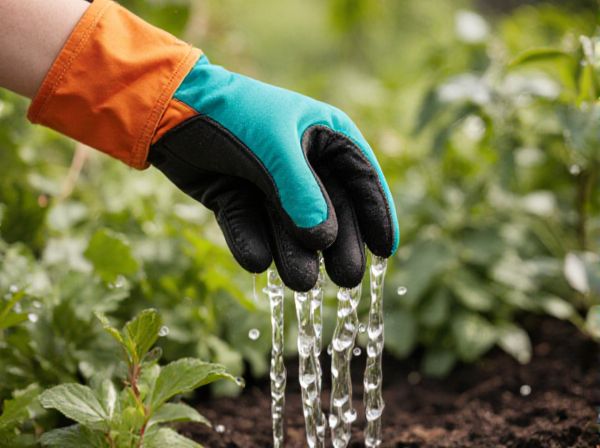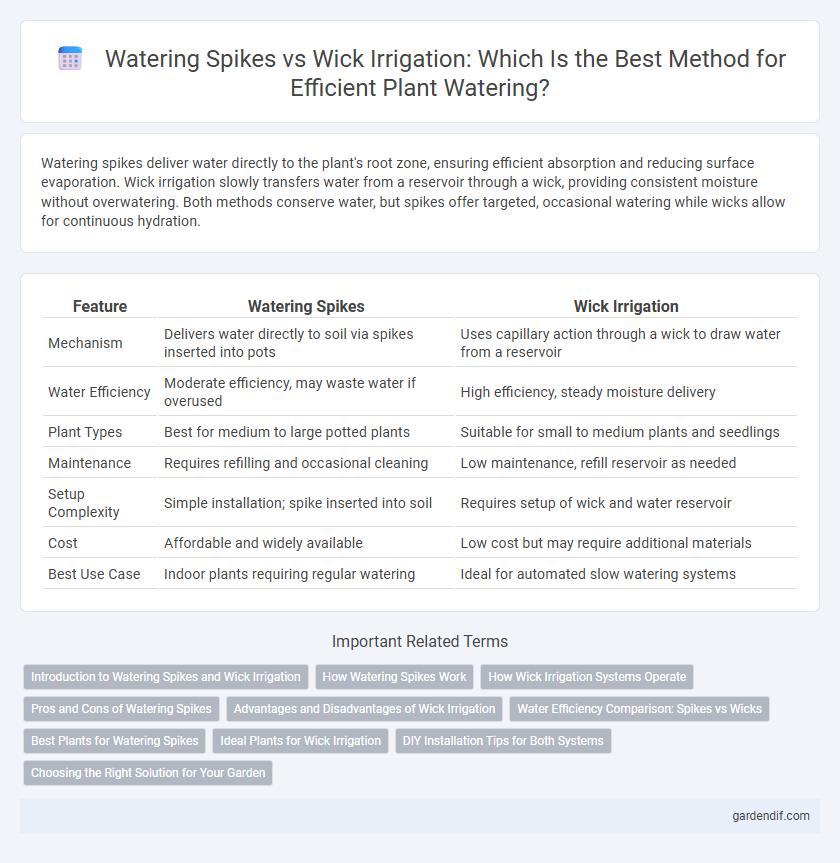
Watering spikes vs Wick irrigation Illustration
Watering spikes deliver water directly to the plant's root zone, ensuring efficient absorption and reducing surface evaporation. Wick irrigation slowly transfers water from a reservoir through a wick, providing consistent moisture without overwatering. Both methods conserve water, but spikes offer targeted, occasional watering while wicks allow for continuous hydration.
Table of Comparison
| Feature | Watering Spikes | Wick Irrigation |
|---|---|---|
| Mechanism | Delivers water directly to soil via spikes inserted into pots | Uses capillary action through a wick to draw water from a reservoir |
| Water Efficiency | Moderate efficiency, may waste water if overused | High efficiency, steady moisture delivery |
| Plant Types | Best for medium to large potted plants | Suitable for small to medium plants and seedlings |
| Maintenance | Requires refilling and occasional cleaning | Low maintenance, refill reservoir as needed |
| Setup Complexity | Simple installation; spike inserted into soil | Requires setup of wick and water reservoir |
| Cost | Affordable and widely available | Low cost but may require additional materials |
| Best Use Case | Indoor plants requiring regular watering | Ideal for automated slow watering systems |
Introduction to Watering Spikes and Wick Irrigation
Watering spikes deliver moisture directly to plant roots through a slow-release system, ensuring efficient water absorption and minimizing surface evaporation. Wick irrigation uses a fabric or rope wick to transfer water from a reservoir to the soil, providing consistent moisture levels without overwatering. Both methods optimize water usage but differ in delivery mechanisms, making them suitable for various plant needs and indoor gardening setups.
How Watering Spikes Work
Watering spikes deliver water directly to the plant's root zone through a tapered spike inserted into the soil, allowing slow, consistent moisture release that minimizes runoff and evaporation. These spikes often connect to a water bottle or reservoir, providing a controlled drip irrigation system that ensures plants receive adequate hydration over time. This method is particularly effective for potted plants and garden beds, promoting deeper root growth and reducing water waste compared to surface watering techniques.
How Wick Irrigation Systems Operate
Wick irrigation systems operate by drawing water from a reservoir through a porous wick material directly into the soil, ensuring consistent moisture delivery to plant roots. Unlike watering spikes that rely on gravity and direct water release into the soil, wicks provide a slow, steady capillary flow that reduces water waste and promotes deep root hydration. This method is especially effective for potted plants and indoor gardening where precise moisture control is critical for healthy growth.
Pros and Cons of Watering Spikes
Watering spikes provide targeted hydration directly to plant roots, reducing water waste and promoting healthier growth. They require less frequent refilling but may clog easily and are less effective in heavy clay soils due to poor water distribution. Compared to wick irrigation, watering spikes deliver water more rapidly but lack the gradual, consistent moisture release ideal for delicate plants.
Advantages and Disadvantages of Wick Irrigation
Wick irrigation offers precise water delivery by using capillary action to transfer moisture from a reservoir directly to plant roots, reducing water waste and promoting consistent hydration. It eliminates runoff and overwatering risks common with spikes, making it energy-efficient and low-maintenance, though it may not support rapid water supply for large or thirsty plants. However, wick systems can become clogged or dry out if the reservoir isn't regularly monitored, requiring careful management for optimal performance.
Water Efficiency Comparison: Spikes vs Wicks
Watering spikes deliver water directly to the root zone, minimizing surface evaporation and promoting deep soil penetration, which enhances water efficiency. Wick irrigation relies on capillary action to transport water from a reservoir to the plant roots, reducing water waste by maintaining consistent moisture levels without overwatering. Studies show that watering spikes can reduce water usage by up to 30% compared to traditional methods, while wick irrigation offers steady water supply but may be less efficient in fast-draining soils.
Best Plants for Watering Spikes
Watering spikes are ideal for deep-rooted plants such as tomatoes, peppers, and roses, delivering water directly to the root zone for efficient absorption. These spikes provide consistent moisture to heavy feeders, reducing the risk of overwatering and promoting healthier growth in container and garden plants. In contrast, wick irrigation suits moisture-loving plants like ferns and African violets that prefer constant surface-level humidity.
Ideal Plants for Wick Irrigation
Wick irrigation is ideal for moisture-loving plants such as ferns, peace lilies, and African violets that require consistent, moderate watering without waterlogging. This method allows a slow, steady water supply from a reservoir to the plant's root zone, reducing the risk of overwatering common with watering spikes. Plants that thrive in evenly moist soil benefit most from wick systems, making them suitable for indoor and container gardening.
DIY Installation Tips for Both Systems
Watering spikes require careful placement near plant roots to ensure efficient water delivery and avoid overwatering; using a sharp tool can help insert spikes deeply into the soil. Wick irrigation systems benefit from selecting appropriate wick materials like cotton or nylon and positioning the water reservoir slightly above the soil level for consistent moisture transfer. Both methods demand monitoring initial water flow rates to prevent under- or over-irrigation during DIY installation.
Choosing the Right Solution for Your Garden
Watering spikes provide targeted deep soil moisture by delivering water directly to plant roots, making them ideal for potted plants and individual garden beds. Wick irrigation offers a passive watering method that consistently supplies moisture by drawing water from a reservoir through a fabric wick, suitable for indoor plants and small container gardens. Selecting between these systems depends on plant type, garden size, and frequency of watering needed to maintain optimal soil hydration.
Watering spikes vs Wick irrigation Infographic

 gardendif.com
gardendif.com